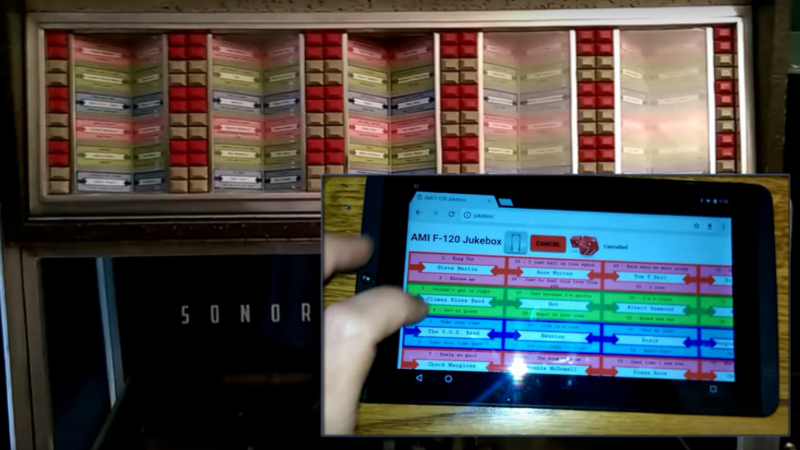Here’s a retro-electronic rehab with a twist. Normally we’d expect a jukebox Raspberry Pi project to replace the obsolete electromechanical guts with streamed music, but an intact jukebox with a Raspberry Pi remote control is a nice change.
Old-time jukes like [revnhoj]’s 1954 AMI F120 are electromechanical marvels. Stocked with 60 45-rpm discs in a horizontal rack, an arm mounted on a track would retrieve the correct disc and place it on the turntable to play the selected song. The unit in the video below was the main jukebox, which supported “wall boxes” mounted at booths so patrons could select tunes without leaving their tables. [revnhoj] simulated a wall box with a Raspberry Pi connected to the original wall box interface through relays. The Pi serves up a GUI that can be accessed via a tablet, the correct contacts are tickled, and [revnhoj]’s collection of 45s is played through the original mechanism and amplifier, in all its “Sonoramic Sound” majesty. It’s a pretty neat hack that adds new functionality while being true to the original platform.
The chatter on the reddit thread where we spotted this hack was trending toward adding streaming audio, but we truly hope the juke stays intact and serving only vinyl. We’ve seen jukeboxes gutted before, and while it might make sense for some, we like the old school approach better.
[via r/raspberry_pi]















How about reverse streaming audio? I.e. tap into the record player output with an ADC and stream it back to the browser.
A real jukebox as a music server, instead of streaming mp3’s it’s v45’s (vinyl 45’s). I like it.
Seconded.Vinyl stream.
Whoa. That’s a great idea!
Nice, I have a wurlitzer silhouette carousel box I rescued that I originally bought to put a sbc in as a fancy box, but managed to fix it instead and now am too taken to butcher it for the original purpose.
I had never of thought of using the wallbox connections to save modifying the innards to allow remote control but its ingenious and neat and reversable.
Do you have a github or anywhere with more docs? I’d like to implement the same one day but use a beaglebone or similar to host the lamp stack and the wurlitzer wallbox so the bits that do the relay io would need altering a bit.
Ok, forgot its a repost as authors usually come here too, but I’ve messaged the guy on youtube see if thats any better.
My husband has an old jukebox he wants to have repaired but isn’t sure where to start. As I was reading your article, you write about how the jukebox repair that you did had a GUI that could be accessed via a tablet. I had no idea that old jukeboxes could be repaired with newer technology.